GLBenchmark 2.5 Performance on Modern Android Smartphones & Tablets
by Anand Lal Shimpi & Brian Klug on July 31, 2012 10:00 AM EST- Posted in
- Smartphones
- GLBenchmark
- Mobile
- Tablets
- SoCs
For quite a while now, GLBenchmark has been a regular test in our smartphone, tablet, and SoC reviews. As GPU performance has steadily increased, GLbenchmark 2.1.x started hitting vsync more of the time in onscreen tests, necessitating an updated version of the test with heavier assests, reworked rendering code, and improved functionality for testing. Today Kishonti Informatics has released GLBenchmark 2.5.0 both on the Google Play store and to partners, and we're taking a first look at performance across the current crop of devices.
GLBenchmark 2.5.0 primarily addresses a few shortcomings from the previous version of the Egypt test, primarily by moving to a more challenging version of Egypt. The new game test is named Egypt HD, and moves to a much more complex scene while keeping roughly the same test animation. Geometry count has increased, texture resolution has increased, there's a new water shader, more reflections, and more shadowing. In addition, the offscreen test has now moved to a default resolution of 1080p instead of the previous 720p, for a more challenging workload. This offscreen resolution is now customizable, but we'll be running 1080p for ease of comparison. In addition, the "classic" Egypt test is also a part of GLBenchmark 2.5.0 for those wishing to compare to 2.1.5. In addition, the triangle and fill subtests also stay around for a lower level look at OpenGL ES 2.0 performance. It should go without saying, but GLBenchmark 2.5 is still an OpenGL ES 2.0 test.
We've run GLBenchmark 2.5.0 on all the devices we have on hand, and have split up the results between tablets and smartphones for ease of comparison. The iOS version of GLBenchmark 2.5.0 is still in the review process, and we'll be updating as soon as we can run that on our iPhone 4S, iPad 2, and iPad 3. For now however, we have a good look at performance for the latest devices in Android land.
Tablets
We have three major SoCs making up our tablet test candidates: NVIDIA's Tegra 3, NVIDIA's Tegra 2 and TI's OMAP 4430. When we get the iOS versions of GLBenchmark 2.5 we'll be able to add the A5 and A5X to this list. We're also waiting on our own Qualcomm MDP/T, which will let us add Adreno 320 results in a few weeks.
The fill and triangle rate tests show us just how far we've come since the days when Tegra 2 and the PowerVR SGX 540 were considered cream of the crop. NVIDIA's Tegra 3 is just significantly faster across the board. The Transformer Pad Infinity's added memory bandwidth (DDR3-1600) helps propel it above the other, lesser Tegra 3 configurations. Again there's nothing new here, just new data that validates what we've already known.
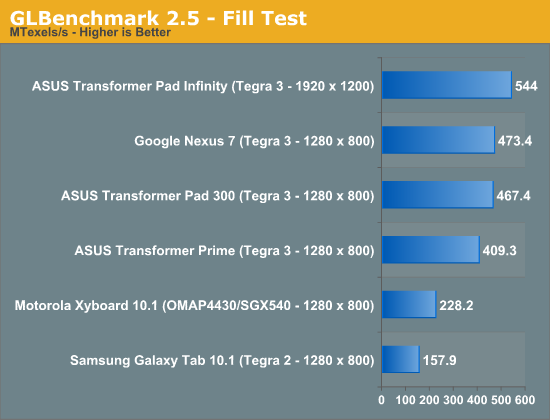
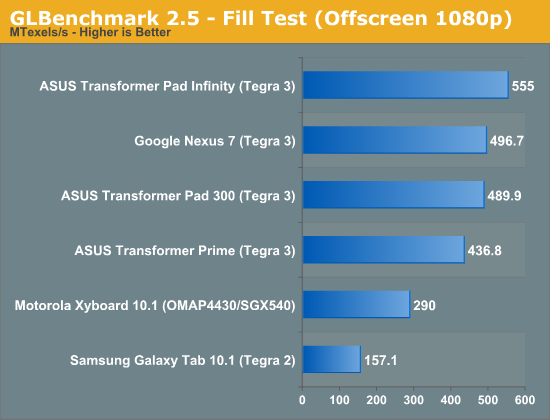
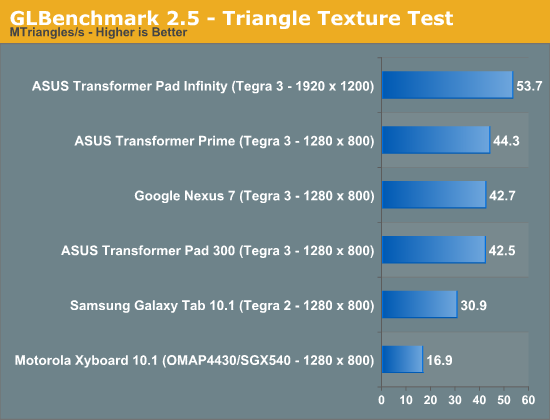
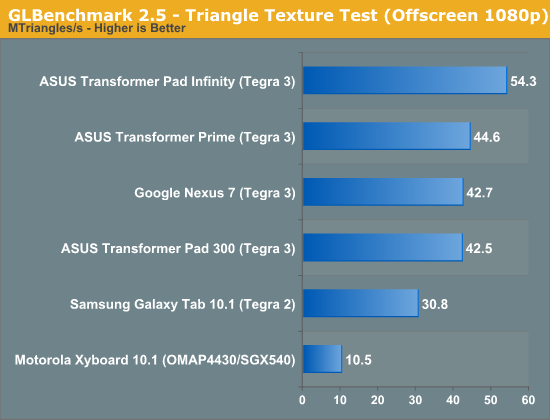
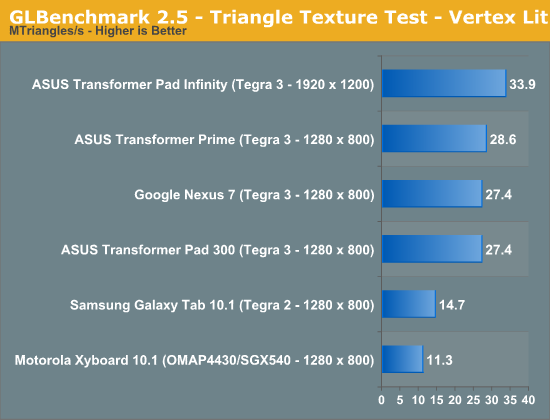
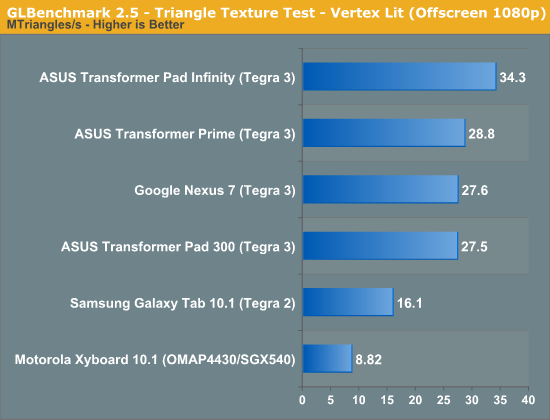


The Egypt HD test raises the bar for what is necessary to produce playable frame rates. At their native resolutions, none of these tablets can even deliver half of a playable 30 fps frame rate. For the next generation of games, we'll need performance around 3x better than NVIDIA's Tegra 3. Qualcomm's Adreno 320 has the ability to deliver that depending on the workload, so it's possible we may see > 30 fps results from it. The A5X should be able to break 30 fps as well, but we'll find out for sure in another day or so.
The offscreen results are even worse. Tegra 3 with DDR3-1600 is still only good for 11 fps. It shouldn't be any surprise, but we will need faster GPUs for better looking games. Egypt HD is definitely the new torture test for mobile SoCs.
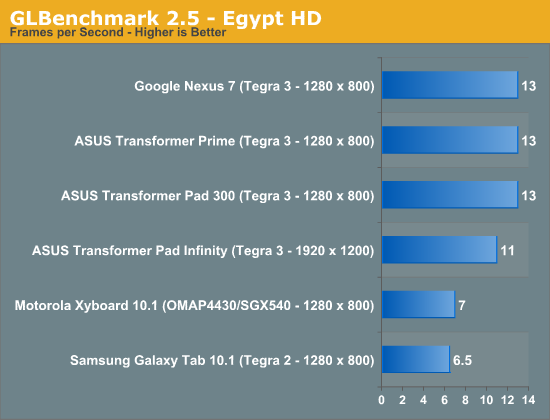
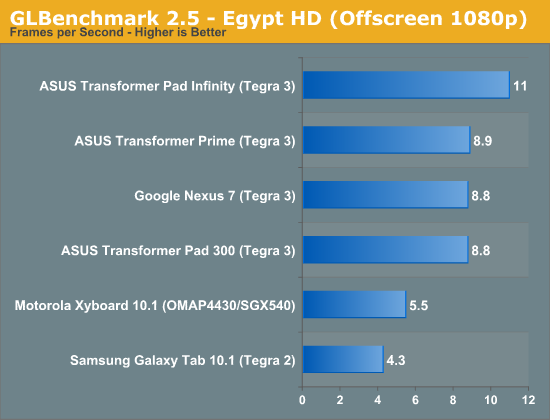
The Egypt Classic test ends up being Vsync limited on the 1280 x 800 Tegra 3 tablets, with even 1920 x 1200 running smoothly on the Transformer Pad Infinity. These numbers echo the reality of 3D gaming on Android today: pretty much everything runs well on Tegra 3.
The same can't be said for Tegra 2 or OMAP 4430 however, even at 1280 x 800 both of these SoCs deliver frame rates well below 30 fps.
The offscreen 1080p results paint a good picture for Tegra 3, which again can deliver average frame rates at or above 30 fps. Anything older than Tegra 3 however just can't pull it off.
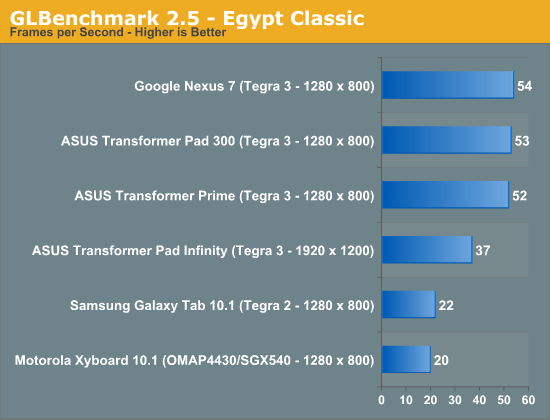



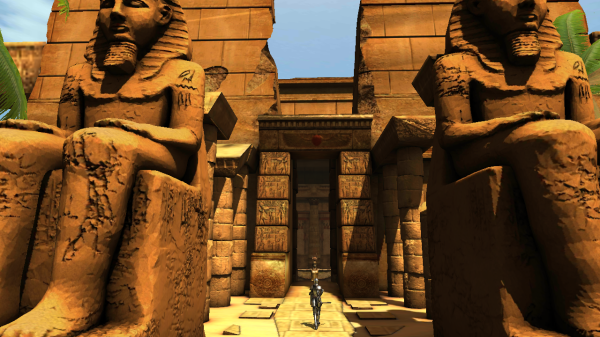














47 Comments
View All Comments
ewood - Tuesday, July 31, 2012 - link
read the article before you ridicule someone's post.aruisdante - Tuesday, July 31, 2012 - link
This is because they Egypt test favors Vertex shading power, and Mali400 is intentionally lacking in that department. If you were to built a test that was pixel shader heavy, the results would be more balanced. You saw this same kind of thing happen in the GeForce 7, Radion X1900 era, when it was nVidia that decided it was better to have more Pixel power than Vertex power. The SGX doesn't haven't to worry about that since it's USA.jeremyshaw - Tuesday, July 31, 2012 - link
I think it was ATi that made the first jump, with the X1950. 48..... 48!! Pixel shaders vs only 16 vertex.Before that, for both ATi and nVidia, it was pretty much always 1:1 pixel:vertex at the top end.
Death666Angel - Tuesday, July 31, 2012 - link
In the game benchmark I see the Quad Exynos being equal to or better than Tegra3. That the Dual Exynos holds its own quite well, considering it launched over half a year earlier. :)At this point though, I wouldn't buy a full price kit with either processor.
Stormkroe - Tuesday, July 31, 2012 - link
Looks like offscreen Mali400 scores are STILL broken in the game tests. Scores 13 fps in 720p and 1080p. Not as bad as going the score going dramatically UP when jumping from 800x400 to 720p like in glbenchmark 2.1, but still... Why hasn't this been addressed?aruisdante - Tuesday, July 31, 2012 - link
Because increasing the resolution increases the load on Pixel shaders more than Vertex shaders, and Mali400 is hamstrung by its Vertex power in this test, so it has the Pixel shading power to spare. It doesn't surprise me that the framerate doesn't change with resolution in this case.Stormkroe - Tuesday, July 31, 2012 - link
But they DO change, in gl2.1 they actually go UP by a lot. That's going from 800x480 to 720p (2.4 times the pixels). Even more proof is that the same SoC in the galaxy note, which has a native resolution very close to 720p used in these off screen tests, shows appropriately scaling performance. It's only when rendering offscreen that Mali400 is able to beat the competition. In glbenchmark2.5 they don't go up, but stay the same, even though there is now a 5.9 factor difference in pixel count. The galaxy note numbers prove that it's not a vertex shader issue. Let's even say that the Mali is so vertex bound (remember it has to be at LEAST 6x deficiency vs the rest of the gpu based on these scores), the fps should still have went down because of the increased demands on the rest of the SoC.I still say offscreen Mali400- broken.
metafor - Tuesday, July 31, 2012 - link
Egypt 2.1 didn't have complex shaders like 2.5. If only one thing in Mali is bottlenecked (like the vertex shader) then nothing else will change. 2.1 simply didn't provide enough complex shaders to bottleneck the vertex shaders, especially at lower resolutions.Stormkroe - Tuesday, July 31, 2012 - link
I'm resisting the urge to go all caps fury here. It's not a bottleneck issue. The offscreen score @720p is HIGHER than the native score at 480p (scores are well below vsync so it can't be that). And offscreen scores @720p are almost double what near-720p resolutions show when they are native.Reduced completely: why does simply going offscreen nearly Double The SCOREOHGOSH I DIDN'T MAKE IT!??!
Rurou - Tuesday, July 31, 2012 - link
I'm also resisting to go all caps, but what are you talking about?Egypt HD:
Galaxy S2 (800x480): 9.1
Galaxy S3 (Mali, 1280x720): 13
Egypt HD offscreen (1080p):
Galaxy S2: 8.8
Galaxy S3 (Mali): 13
Egypt Classic:
Galaxy S2: 60
Galaxy S3: 59
Egypt Classic offscreen (1080p):
Galaxy S2: 31
Galaxy S3: 57
What is the point that you're trying to make? I don't understand. Have you downloaded GLBenchmark 2.5?
All hardware have lower fps on offscreen test, with the exception of Galaxy S3, which suggest that Galaxy S3 was severely vertex limited.. heck, even Galaxy S2 is severely vertex limited because that kind of difference is usually within the margin of error.
Where is this double thing that you mentioned? or are you seeing double? Or are you talking something that wasn't presented in the article? If that is the case, then in what way it affects the result from the article?